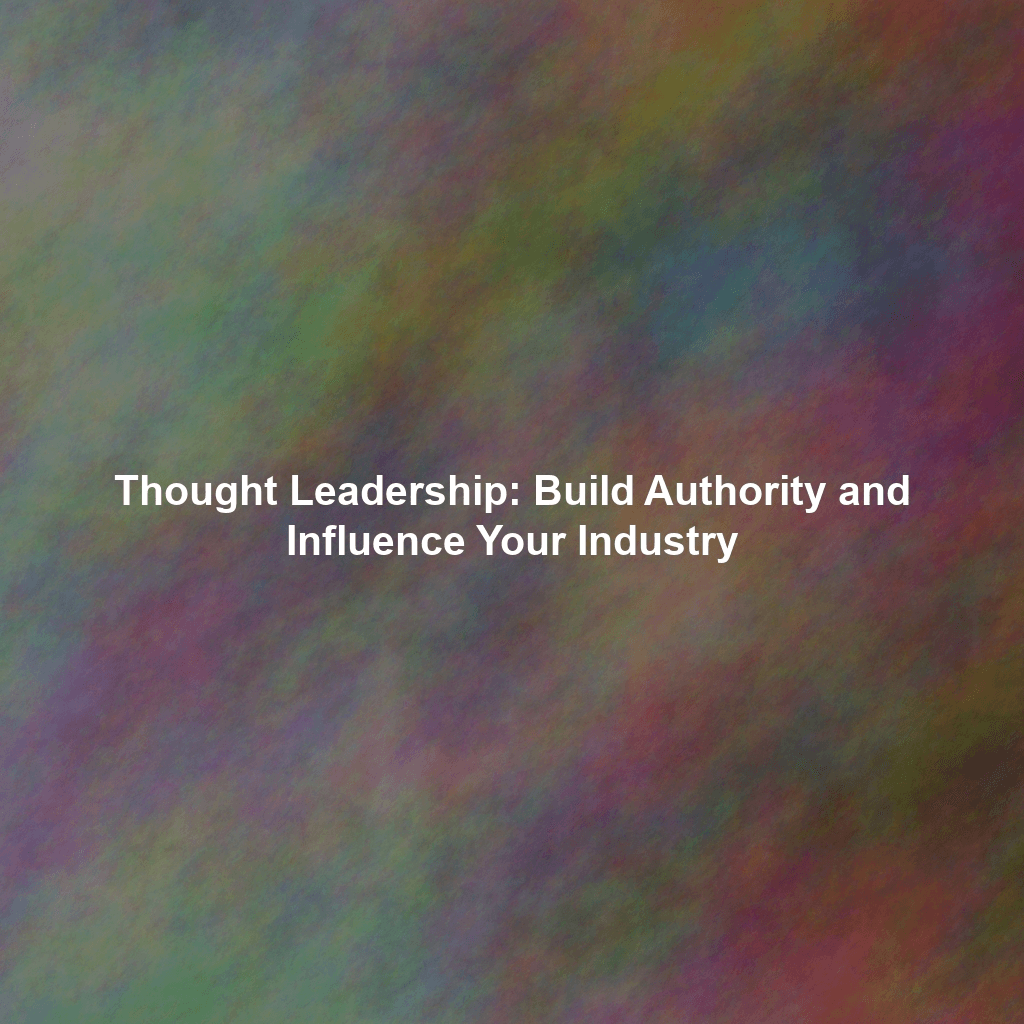What is Thought Leadership Content and Why Does it Matter?
So, what exactly qualifies as “thought leadership content”? It’s content that:
- Offers unique perspectives: Goes beyond the surface level and provides a fresh take on industry topics.
- Shares valuable insights: Delivers actionable advice, data-driven findings, and practical solutions.
- Demonstrates expertise: Showcases your deep understanding of your field and your ability to solve complex problems.
- Engages the audience: Sparks conversation, encourages participation, and fosters a sense of community.
- Is backed by research and evidence: Supports claims with data, case studies, and real-world examples.
Developing a Content Strategy for Thought Leadership
Before you start churning out blog posts and recording podcasts, it’s crucial to have a solid content strategy in place. This strategy will serve as your roadmap, guiding your content creation efforts and ensuring that you’re consistently delivering value to your target audience. Here’s how to develop a winning thought leadership content strategy:
1. Define Your Niche and Target Audience
What specific area of expertise do you want to be known for? Who are you trying to reach with your content? The more clearly you define your niche and target audience, the more effective your content will be. Consider their pain points, challenges, and aspirations. What questions are they asking? What information are they seeking?
For example, instead of broadly targeting “marketing,” you might focus on “email marketing automation for e-commerce businesses.” This allows you to create more targeted and relevant content that resonates with a specific audience.
2. Identify Your Key Themes and Topics
Once you know your niche and target audience, brainstorm a list of key themes and topics that you want to cover in your content. These themes should be aligned with your areas of expertise and relevant to your audience’s interests. Conduct keyword research to identify popular search terms and trending topics in your industry. Tools like Google Keyword Planner, SEMrush, and Ahrefs can be invaluable in this process.
3. Choose the Right Content Formats
The format of your content can significantly impact its reach and engagement. Experiment with different formats to see what resonates best with your audience. Some popular options include:
- Blog Posts: A classic format for sharing your thoughts and insights on a variety of topics.
- White Papers: In-depth reports that provide detailed analysis and solutions to specific problems.
- Ebooks: Longer-form content that offers a comprehensive guide to a particular subject.
- Webinars: Online presentations that allow you to interact with your audience in real-time.
- Podcasts: Audio content that can be consumed on the go.
- Videos: Engaging visuals that can be used to explain complex concepts or share your personal story.
- Infographics: Visually appealing representations of data and information.
- Case Studies: Real-world examples of how you’ve helped clients or customers achieve success.
Consider repurposing your content across multiple formats to maximize its reach. For example, you could turn a blog post into a series of social media updates, or a webinar into a podcast episode.
4. Create a Content Calendar
A content calendar is an essential tool for staying organized and consistent with your content creation efforts. It outlines what content you’ll be creating, when you’ll be publishing it, and where you’ll be promoting it. Use a spreadsheet, project management software, or dedicated content calendar tool to keep track of your content schedule.
5. Promote Your Content
Creating great content is only half the battle. You also need to promote it effectively to reach your target audience. Share your content on social media, email newsletters, and relevant online communities. Consider collaborating with other thought leaders in your industry to cross-promote each other’s content.
6. Measure and Analyze Your Results
Track your content’s performance to see what’s working and what’s not. Monitor metrics like website traffic, social media engagement, lead generation, and sales conversions. Use this data to refine your content strategy and improve your results over time.
Best Practices for Creating Compelling Thought Leadership Content
Creating effective thought leadership content requires more than just writing skills. Here are some best practices to keep in mind:
1. Focus on Providing Value
The primary goal of thought leadership content is to provide value to your audience. Don’t focus on self-promotion or sales pitches. Instead, focus on sharing your expertise, insights, and solutions to help your audience solve their problems and achieve their goals.
2. Be Original and Authentic
In a world of generic content, originality is key. Share your unique perspective and don’t be afraid to challenge conventional wisdom. Authenticity is also crucial. Be yourself and let your personality shine through in your content.
3. Back Up Your Claims with Evidence
Don’t make claims without backing them up with evidence. Use data, research, case studies, and real-world examples to support your points. This will build trust and credibility with your audience.
4. Write in a Clear and Concise Style
Make your content easy to read and understand. Use clear and concise language, avoid jargon, and break up long paragraphs into shorter, more digestible chunks. Use headings, subheadings, and bullet points to improve readability.
5. Engage with Your Audience
Thought leadership is a two-way street. Encourage your audience to share their thoughts and opinions by asking questions and prompting discussions. Respond to comments and questions promptly and thoughtfully. Consider hosting live Q&A sessions or online forums to engage with your audience in real-time.
6. Stay Up-to-Date on Industry Trends
To be a true thought leader, you need to stay on top of the latest industry trends and developments. Read industry publications, attend conferences, and follow thought leaders on social media. Share your insights on these trends in your content.
7. Be Consistent
Consistency is key to building a loyal audience. Publish new content on a regular basis to keep your audience engaged and coming back for more. A consistent content schedule will also improve your search engine rankings.
Examples of Effective Thought Leadership Content
To give you a better idea of what thought leadership content looks like in practice, here are some examples:
- A CEO publishes a blog post on the future of their industry. They share their vision for the future and offer insights into the challenges and opportunities that lie ahead.
- A marketing agency creates a white paper on the latest trends in social media marketing. They provide in-depth analysis and actionable advice for businesses looking to improve their social media strategy.
- A software company hosts a webinar on how to use their product to solve a specific business problem. They demonstrate the product’s features and benefits and answer questions from attendees.
- An entrepreneur shares their personal story of overcoming challenges and achieving success. They inspire others to pursue their dreams and offer valuable lessons learned along the way.
- A research firm publishes a report on the impact of artificial intelligence on the workforce. They provide data-driven insights and predictions for the future of work.
The Long-Term Benefits of Investing in Thought Leadership
While the initial investment in creating thought leadership content may seem significant, the long-term benefits are well worth the effort. By consistently delivering high-quality content that establishes you as an authority in your industry, you can:
- Build Trust and Credibility: Thought leadership content helps you build trust with your audience by demonstrating your expertise and providing valuable insights.
- Attract New Customers and Clients: By positioning yourself as an authority, you can attract new customers and clients who are seeking expert advice and solutions.
- Generate Leads: Thought leadership content can be used to generate leads by offering valuable resources in exchange for contact information.
- Increase Brand Awareness: Thought leadership content helps you increase brand awareness by getting your name and message in front of a wider audience.
- Improve Search Engine Rankings: High-quality content that is optimized for search engines can improve your website’s ranking in search results.
- Attract Top Talent: Thought leadership can attract top talent to your company by showcasing your company’s expertise and vision.
- Influence Industry Trends: By sharing your unique perspectives and insights, you can influence industry trends and shape the future of your field.
Conclusion
Thought leadership content is a powerful tool for establishing expertise, building trust, and driving business growth. By developing a content strategy, creating compelling content, and promoting it effectively, you can position yourself as an authority in your industry and reap the many benefits of thought leadership. It’s not a quick fix, but a sustained and strategic approach to sharing your knowledge and adding value to the world. So, start creating valuable content today and watch your influence grow!
 Skip to content
Skip to content

